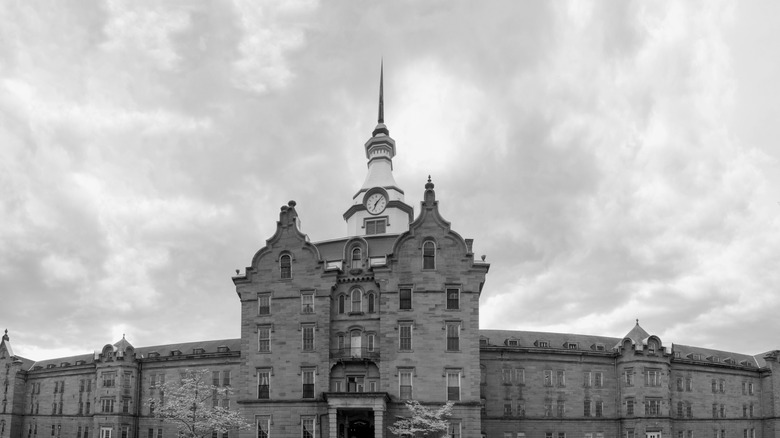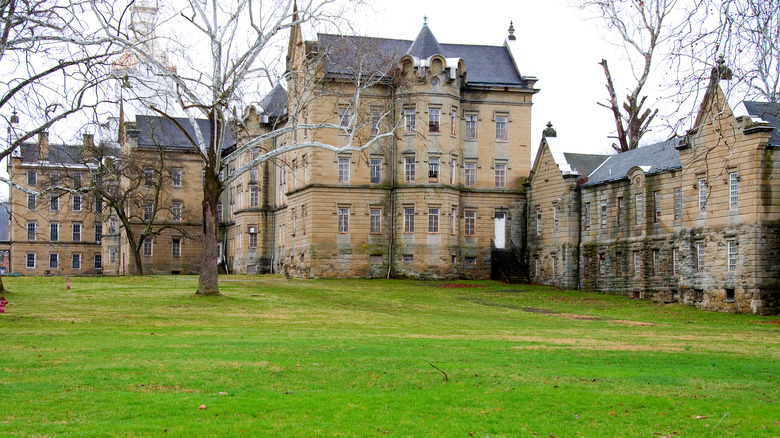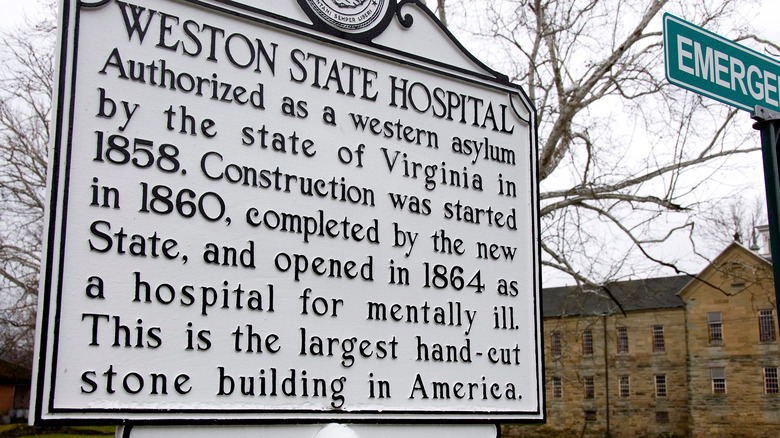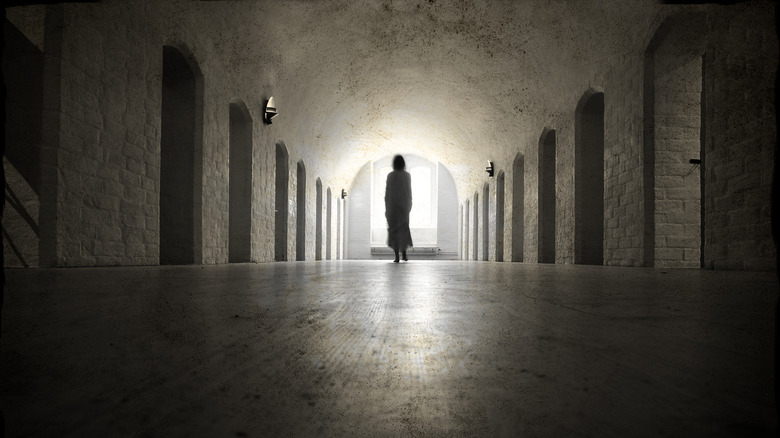This West Virginia Asylum Is Said To Be One Of The Most Haunted Places In America
Just based on its name, many people would probably assume that the Trans-Allegheny Lunatic Asylum is one of the most haunted places in not just West Virginia but also the entire United States. The place checks multiple boxes on a list of common historical traits shared by a lot of allegedly haunted locations. It's a mental hospital from an era when the way the mentally ill were treated could be described in many ways — "humane" not being one of them. It was also around during the Civil War, a frequent source of haunting fodder, and the land it sits on was once used by the Union Army in the late 1850s (via Charleston Gazette-Mail).
The asylum was in operation all the way until 1994, when it shut its doors, as least as a functioning medical facility. These days, it's a hotspot for thrill-seekers in search of a good scare and possible brush with the paranormal.
If you or someone you know is struggling with mental health, please contact the Crisis Text Line by texting HOME to 741741, call the National Alliance on Mental Illness helpline at 1-800-950-NAMI (6264), or visit the National Institute of Mental Health website.
The early days of mental health treatments in America
In colonial America, those with mental illnesses had practically no hope of receiving the kind of treatment that would help them manage their condition. Quite the opposite, they were often punished, some even being accused of witchcraft, which was believed to be the cause of their experiences (via Trans-Allegheny Lunatic Asylum). It wasn't until the 19th century that social reformers like Dorothea Dix started to fight for change in how the mentally ill were cared for and treated.
Dix herself traveled around the world observing the way mental health patients were cared for and fought legislation to bring change. Her work was also instrumental in getting a mental hospital up and running in Trenton, New Jersey, in 1848 (via PBS). However, her efforts and the horrific things she saw during her work led her to suffer several nervous breakdowns, and she even became a patient at the hospital in New Jersey that she helped open, per Women's History.
The Trans-Allegheny Lunatic Asylum building itself was designed to treat patients
The Trans-Allegheny Lunatic Asylum's design was inspired by Dr. Thomas Story Kirkbride. Kirkbride was the superintendent at the Pennsylvania Hospital for the Insane and a proponent of "moral treatment," which was simply the idea that the mentally ill should be treated with respect and compassion, not chained to walls as was common for the era, according to Penn Medicine.
According to Britannica, Kirkbride developed a set of ideas that became known as the Kirkbride Plan, which argued that a hospital's design could have a positive effect on patients. He published these ideas in his 1854 book, "On the Construction, Organization and General Arrangements of Hospitals for the Insane." The idea was that the hospital itself would be made up of a central building with hospital wings that branched off of it. Another key component of the Kirkbride Plan was to limit the number of patients to 250 at most and let them roam around the building.
Construction started in the 1850s but was put on hold in 1858 when the Union Army needed the land. The building, which was only partially constructed, became a military outpost (via Trans-Allegheny Lunatic Asylum).
The asylum was often overcrowded
Not long after opening its doors to patients, the Trans-Allegheny Lunatic Asylum ran afoul of one of Dr. Thomas Story Kirkbride's major ideas: that the hospital capacity shouldn't exceed 250 patients. That was the number the hospital was designed to hold, but according to the Washingtonian, as many as 2,400 people were shoe-horned into the building. The hospital was designed to allow sunlight and fresh air inside for therapeutic benefits, but those benefits were nullified by the immense overcrowding, which reached its peak in the 1950s (via Trans-Allegheny Lunatic Asylum). This also meant that the conditions the residents were living in decreased a great deal.
It's somewhat shocking that these conditions lasted as long as they did, as they were no secret to the general public. Way back in 1887, investigative reporter Nellie Bly committed herself to an insane asylum in New York for 10 days and wrote an expose for the New York World about her experiences. The story only confirmed the shocking rumors that inspired it in the first place (via Biography).
Closure of the asylum
In the 1930s, a tragedy struck the Trans-Allegheny Lunatic Asylum. A fire — thought to be one of several that patients started over the years, per Legends of America — ripped through the building's fourth floor and caused over $100,000 in damage.
Through the 20th century, when the asylum population was at its highest, it cared for patients with a wide range of afflictions, including people with epilepsy, those with developmental issues, and even people experiencing addiction. It was no secret that the conditions at the asylum (which had been renamed Weston State Hospital in 1913, per The Culture Trip) had become unsanitary and unhealthy for those confined within. Newspapers like the Charleston Gazette were even publishing stories on the matter as early as 1949. Still, the asylum continued operating and even used some horrific treatment methods. According to All That's Interesting, one of these was known as the ice pick method, which consisted of inserting an ice pick or similarly thin piece of metal through a patient's eye socket to perform a lobotomy. The practice wound up killing several patients.
In 1994, amid changes in mental health treatment practices and a decline in the conditions of the nearly 150-year-old building, the asylum was closed. In the 2000s, it was purchased, and it now plays host to tour groups — some designed to show off the historical landmark and others to showcase its alleged current residents.
Hauntings at Trans-Allegheny Lunatic Asylum
Today, the building is best known for its alleged frequent paranormal activity. According to the Washingtonian, the building's ghost roster is as wide-ranging as the patients who were treated there. They are said to include a little girl who is believed to have been born in the building, a man who died of a heart attack while taking a bath, another man who was allegedly murdered by his fellow patients, and, of course, it wouldn't be a haunted building in the eastern United States if there haven't been sightings of Civil War soldiers wandering around the grounds.
The Charleston Gazette-Mail reported that the asylum's profile has been elevated since it was closed and became a haunted attraction and was even named the most haunted place in West Virginia. Should you find yourself in that part of the country and want to have the hairs on the back of your neck stand on end, there's good news: the Trans-Allegheny Lunatic Asylum offers tours every hour on the hour (except on Mondays), giving visitor's ample opportunities to learn about the site's history and maybe even catch a glimpse of a spirit.





